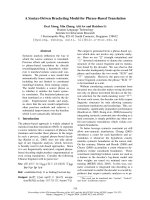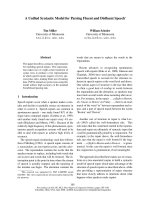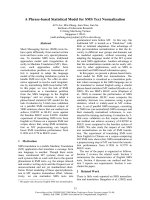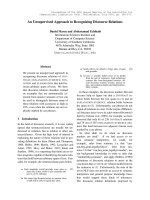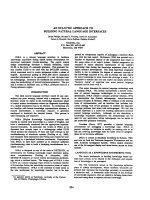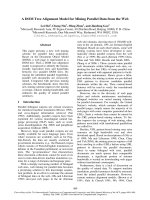Báo cáo khoa hoc:" A quasi-score approach to the analysis of ordered categorical data via a mixed heteroskedastic threshold model" pdf
Bạn đang xem bản rút gọn của tài liệu. Xem và tải ngay bản đầy đủ của tài liệu tại đây (763.13 KB, 18 trang )
Original
article
A
quasi-score
approach
to
the
analysis
of
ordered
categorical
data
via
a
mixed
heteroskedastic
threshold
model
Florence
Jaffrézic,
Christèle
Robert-Granié.
Jean-Louis
Foulley*
Station
de
génétique
quantitative
et
appliquée,
Institut
national
de
la
recherche
agronomique,
Centre
de
recherches
de
Jouy-en-Josas,
78352
Jouy-en-Josas
cedex,
France
(Received
15
December
1998;
accepted
21
April
1999)
Abstract -
This
article
presents
an
extension
of
the
methodology
developed
by
Gilmour
et
al.
[19],
for
ordered
categorical
data,
taking
into
account
the
hetero-
geneity
of
residual
variances
of
latent
variables.
Heterogeneity
of
residual
variances
is
described
via
a
structural
linear
model
on
log-variances.
This
method
involves
’
two
main
steps:
i)
a
’marginalization’
with
respect
to
the
random
effects
leading
to
quasi-score
estimators;
ii)
an
approximation
of
the
variance-covariance
matrix
of
the
observations
which
leads
to
an
analogue
of
the
Henderson
mixed
model
equations
for
continuous
Gaussian
data.
This
methodology
is
illustrated
by
a
numerical
example
of
footshape
in
sheep.
©
Inra/Elsevier,
Paris
generalized
linear
mixed
models
/
quasi-score
/
heterogeneity
of
variances
/
threshold
response
model
Résumé -
Une
approche
de
quasi-score
pour
l’analyse
de
variables
qualitatives
ordonnées
par
un
modèle
mixte
à
seuils
hétéroscédastique.
Cet
article
présente
une
extension
de
la
méthodologie
développée
par
Gilmour
et
al.
!19!
dans
le
cas
de
variables
qualitatives
ordonnées,
prenant
en
compte
l’hétérogénéité
des
variances
résiduelles
des
variables
latentes.
L’hétérogénéité
des
variances
résiduelles
est
décrite
par
un
modèle
linéaire
structurel
sur
les
logarithmes
des
variances.
Cette
méthode
comprend
deux
étapes
principales :
i)
une
« marginalisation
» par
rapport
aux
effets
aléatoires
qui
conduit,
grâce
aux
équations
de
quasi-score,
à
l’estimation
des
paramètres ;
ii)
une
approximation
de
la
matrice
de
variance-covariance
des
observations
qui
aboutit
à
un
système
analogue
aux
équations
du
modèle
mixte
d’Henderson
dans
le
cas
de
variables
continues
gaussiennnes.
Cette
méthodologie
est
illustrée
par
un
exemple
sur
la
forme
des
pieds
chez
le
mouton. @
Inra/Elsevier,
Paris
modèles
linéaires
généralisés
mixtes
/
quasi-score
/
variances
hétérogènes
/
modèle
à
seuils
*
Correspondence
and
reprints
E-mail:
foulleyCjouy.inra.fr
1.
INTRODUCTION
The
threshold
model
is
one
of
the
most
popular
models
for
analysing
ordered
categorical
data
especially
in
population
[36,
37]
and
quantitative
[7]
genetics
as
well
as
in
animal
breeding
!16).
Recently
Foulley
and
Gianola
[8]
extended
the
standard
threshold
model
to
a
model
allowing
for
heterogeneous
variances
of
the
Gaussian
latent
variables
using
a
log-linear
model
for
the
residual
variances.
In
the
case
of
mixed
models,
they
proposed
to
base
inference
about
threshold
cutoff
points,
location
and
dispersion
parameters
of
the
latent
distribution
on
the
mode
of
the
a
posteriori
(MAP)
distribution.
This
approach
is
basically
a
conditional
one
(given
random
effects)
and
is
similar
to
penalized
quasi-likelihood
(l,
31),
iterated
re-weighted
restricted
maximum
likelihood
[5]
and
hierarchical
likelihood
of
generalized
linear
mixed
models
[28]
for
one
parameter
exponential
families.
As
discussed
by
Foulley
and
Manfredi
[10]
and
Engel
and
Keen
[6],
these
procedures
are
likely
to
have
some
drawbacks
regarding
the
estimation
of
fixed
effects
due
to
the
approximation
in
integrating
out
random
effects.
One
simple
way
to
overcome
the
difficulty
of
an
exact
integration
of
random
effects
is
the
quasi-score
approach
of
Me
Cullagh
and
Nelder
[30]
which
only
requires
the
mean
and
variance
of
the
data
distribution.
In
particular,
an
appealing
version
of
the
quasi-score
approach
for
computing
estimations
of
fixed
effects
was
proposed
by
Gilmour
et
al.
[18,
19]
using
an
approximation
of
the
variance-covariance
matrix.
One
of
the
main
advantages
of
this
method
is
that
it
mimics
the
mixed
model
equations
of
Henderson
[23]
making
the
estimation
of
fixed
effects
computationally
easier
and
providing
analogues
of
BLUP
(best
linear
unbiased
predictor)
of
random
effects
as
by-products.
Moreover,
this
quasi-score
method,
via
linearization,
was
proven
to
be
quite
general
[1,
21,
39].
Initially
derived
by
Gilmour
et
al.
[18]
for
binary
data
modelled
with
logit
or
probit
links,
it
was
applied
to
ordered
categorical
data
by
the
same
authors
!19),
to
Poisson
data
with
a
log
link
by
Foulley
and
1m
[9]
and
to
a
log
link
exponential
model
by
Trottier
[35).
The
purpose
of
this
paper
is
to
show
how
this
procedure
can
also
cope
with
heterogeneous
residual
variances
in
the
case
of
ordered
polytomics
modelled
via
Gaussian
latent
variables.
Section
2
entitled
’Theory’
outlines
the
model,
the
quasi-score
equations
and
their
GAR
[19]
counterpart
and
by-products.
Section
3
illustrates
the
theory
using
the
numerical
example
of
footshape
in
sheep
presented
by
GAR
!19).
2.
THEORY
2.1.
Model
The
model
assumptions
and
notations
are
basically
the
same
as
in
Foulley
and
Gianola
[8].
First,
it
is
assumed
that
the
population
can
be
stratified
according
to
an
index
i
(i
=
1, 2, , I)
such
that
the
between
subgroup
variation
corresponds
to
systematic
influences
of
identified
factors
and
the
within
group
variation
to
random
noise.
There
are
J
response
categories
indexed
by j
such
that
y
2+ _
(y
ij+
)
represents
the
vector
of
the
counts
of
responses
for
subpopulation
i in
the
n!
different
categories
j.
The
vector
y
i+
can
be
expressed
as
the
sum
yi
+
_
L
y
2r
r=l
of
indicator
vectors
y
ir
=
(Yiln
?2! ’ — ;
!r; — ’;
yi.Jr!!
such
that
y7
,j
r
=
1
if
response
of
observation
r
in
subpopulation
i
is
in
category j
and
y
ij
,
=
0
otherwise.
In
the
threshold
approach,
the
probability
of
a
response
in
category j
for
an
observation
of
population
i,
say
!rij,
is
described
by
the
distribution
of
continuous
latent
variables
giro,
The
expression
of
these
variables
is
discretized
via
threshold
values
(!l, !2,
!j
!,!-1),
(!o
= !oo
and
!j
=
+oo)
such
that:
A
mixed
model
structure
is
hypothesized
on
the
latent
variable:
where
r!Z
=
E(£
ir
)
is
decomposed
as
a
linear
function
x,)/3
of
explanatory
variables
(row
vector
xi’)
with
unknown
coefficients
/3
E
IR
P;
!!zzzu*
represents
the
contribution
of
random
effects
to
the
model
with
u*
being
a
(q
x 1)
vector
of
scaled
deviations,
zi
the
corresponding
row
incidence
vector
and
!!!
the
square
root
of
the
u-component
of
variance,
which
may
vary
between
subpopulations.
Classical
assumptions
are
made
regarding
the
distribution of
u*
and
ei
=
{eir},
i.e.
u*
- M(0, Iq)
or,
in
genetics,
u*
- M(0, A)
where
A
represents
the
known
relationship
matrix,
ei
-
N
(0,
Q
e.
Ini)
and
Cov( u,
ei’)
=
0.
Homogeneity
of
the
covariate
structure
is
assumed
within
the
subpopulation
i,
i.e.
xi,
=
xi
and
z
ir
=
z7
,.
If
not
(e.g.
when
xi
is
a
continuous
covariate),
smaller
units
will
be
considered,
even
at
the
limit
elementary
units
(n
2
=
1).
Moreover,
as
in
Foulley
and
Gianola
(8!,
the
ratio
pi
=
u
uj
u
ei
is
assumed
to
be
constant
(p)
across
populations
which
is
equivalent
to
supposing
homoge-
neous
intra-class
correlations
(e.g.
constant
heritability
or
repeatability)
across
environments.
Thus,
with
ai
=
z’Azi.
In
many
applications,
ai
is
a
constant
or
even
ai
=
1,
but
this
simplification
is
not
mandatory
throughout
this
paper.
In
fact,
the
theory
is
presented
here
with
a
single
random
factor
but
it
can
be
easily
extended
to
any
number
K
of
independent
random
vectors
uk.
Similarly
for
the
expectations,
a
structure
is
postulated
for
residual
variances
so
as
to
account
for
the
effects
of
factors
causing
heteroskedasticity.
As
in
Foulley
et
al.
[13,
14],
heterogeneity
of residual
variances
is
described
by
a
structural
linear
model
and
a
log
link
function,
as
follows:
where
p’
is
the
(1
x
r)
row
vector
of
covariates
and 6
is
the
(r
x
1)
vector
of
real-valued
dispersion
parameters.
2.2.
Estimation
The
estimation
procedure
described
here
includes
two
steps.
The
first
step
consists
in
setting
up
the
quasi-score
equations
based
on
the
first
two
marginal
moments
according
to
the
quasi-likelihood
theory
[30]
and
its
extension
to
correlated
observations
[29].
The
second
step
lies
in
replacing
the
variance-
covariance
matrix
of
observations
by
an
approximation
which
is
analogous
to
solving
for
fixed
effects
using
the
mixed
model
equations
of
Henderson
(23].
2.2.1.
(!uasi-score
equations
Let
e
=
(ç’,
13’,
6’)’
be
the
(J -
1
+
p
+
r)
vector
of
parameters
of
interest,
where
!!! J_1) X 1)
are
the
thresholds,
!3!pX 1)
the
location
parameters,
and
6<r x i!
the
dispersion
parameters.
The
quasi-score
equations
are:
where
Y(
7
(j-i)xi)
=
(Yi! Y2! ! ! ! !Yi, ! ! ! !Yi)!
is
the
vector
of
the
observed
cumulative
proportions
with
y2!!!_l!Xl!
=
LYZ+!ni,
L
is
a
((J- 1)
x
J)
matrix
built
from
a
lower
triangular
matrix
of
Is,
the
last
row
of
which
is
removed.
In
addition,
p
=
E(y), E
=
Var(y)
and
D’ =
0p’/05
with
dimension
((J + p + r - 1)
x I(J - 1)).
Equations
in
(6)
need
to
specify
p
and E
which
can
be
performed
as
follows.
j
Let
Mij
) !
7r
ik
.
The
conditional
expectation
of
Mij
given
realized
values
k-
1
of
the
random
effects
u*
is
defined
as
Mi
j (u
*)
=
Pr(P2r !
!j I u*)
which,
due
to
the
distribution
assumptions
made,
can
be
expressed
as
a
normal
cumulative
density
function
(CDF):
In
the
marginal
model,
1-
iij
is
the
expectation
of
fJi
j ( u
*)
with
respect
to
the
distribution
of
u*.
Remember
that
if
X N
N(
fJ,u
2
),
the
E(4
l
(X)) =
!(!(1
+
(2
)-
1/2)
!2!.
Here,
the
expectation
of
(7)
reduces
to:
As
shown
in
detail
in
the
Appendix,
the
variance-covariance
matrix E
of
the
observations
can
be
decomposed
as
the
sum
of
two
components:
The
first
component E
A
is
a
(I(J -
1)
x
I(J -
1))
block
diagonal
matrix
such
that:
In
equation
(11),
Eo,
ii
is
a
((J -
1)
x
(J -
1))
matrix
whose
general
term
I
is
(
170
,
ii
)
jk
=
fJij(1 -
fJik
)
for
j,
k =
1, ,
(J -
1),
so
that E
= i(D1
(Eo,!2)/ni
t=i
is
the
variance-covariance
matrix
of
observations
for
multinomial
data
(i.e.
a
purely
fixed
model).
The
second
component
EB
corresponds
to
the
covariance
terms
for
off-
diagonal
blocks,
i.e.:
For
any
pair
of
blocks
(diagonal
i =
i’
or
off-diagonal i =1=
i’)
its
general
term
( j k)
can
be
expressed
as:
where
tii!
is
the
correlation
coefficient
between
f j,
and
e2!r!
and
4l2
(a,
b;
r)
is
the
CDF
of
the
standardized
binormal
distribution
with
arguments
a,
b,
and
correlation
r.
The
system
in
equation
(6)
can
be
solved
by
Fisher’s
iterative
algorithm
as
follows:
where
De(t+1
) =
e(
t
+1)
- e
(t),
D’ =
Ott’100
can
be
decomposed
as
(9V/!)(!/!).
Now
it
i,
=
4)(-y
ij
)
so
that:
with <P =
EB
(pi
and o
i
=
diag{4>hij)}
for j
=
1, 2, ,
(J -
1),
where
4>(.)
is
i=l
the
standardized
normal
density
function.
The
second
element
can
be
written
as
the
product:
and
Wi
=
!/1 +!o’!.
Replacing
D’
in
equation
(14)
by
its
combined
expression
D’
=
T’H’o
from
equations
(15)
and
(16)
leads
to
an
iterative
generalized
least
square
system:
where
W(1(!_1!x1(J-1!! _
!E 1!
is
a
matrix
of
weights,
and
v
=
HTO +
o- 1 (,! -
p)
is
a
working
variable.
Both
are
updated
from
round
(t)
to
round
(t
+
1)
of
iteration
using
the
current
value
B(t!
of
0.
2.2.2.
The
GAR
procedure
The
size
(I(J —
1))
of
the E
matrix
to
invert
in
W
may
be
very
large
in
some
types
of
applications
(e.g.
genetic
evaluation
of
field
data).
This
precludes
the
use
of
the
equation
system
(20)
for
computing 0
estimates.
This
was
the
basic
reason
why
Gilmour
et
al.
[18]
proposed
an
alternative
procedure
based
on
a
convenient
approximation
of
E,
whose
principle
was
explained
in
detail
in
Foulley et
al.
!12!.
Let
Q(a,
b;
r) =
4l2 (a,
b;
r) -
4l(a)lF(b) .
Using
Tallis’s
[34]
result
viz
i9Q/Or
=
4
>2 (a, b; r)
(
02
(-):
standardized
bivariate
density
with
arguments
a,
b and
correlation
r),
the
first
order
Taylor
expansion
of
S2(a, b; r)
about
r
=
0 is
S2(a,
b;
r) =
r4>(a)4>(b)
+
o(r
2
).
Applying
this
to
a
=
!y2!,
b
=
!y2!!
and
r
= tii&dquo;
which
occur
in
the
general
term
of
EB,
iil
(cf.
equation
(13)),
leads
to:
This
can
also
be
written
as:
where
<P
i
and
z§
are
as
previously
defined,
G
=
Ap
2,
Mi
= - 1 < j- i> Wi !
(1<k>
is
a
vector
of
k
ones
and
the
minus
sign
is
used
for
the
convenience
of
calculation).
!
I
Letting
Z!IX9) -
(zi,Z2, ,z,;, ,z!,
M!l!!-li X1! - ! Mz
and
1=1
Z!1!.!-1!X9)
=
MZ, E
and
its
components
can
be
expressed
in
condensed
form
as:
where
EA
is
the
same
as
defined
in
equations
(10)
and
(11)
with
block
diagonal
terms
of
EB
replaced
by
their
approximations
given
in
equation
(23).
Substituting E
in
W-
1
=
<
p-l
¿,4>-
l
by
its
expression
in
equation
(24),
one
has:
which
displays
the
classical
form
R +
Z*
GZ*!
of
a
variance-covariance
matrix
of
data
under
a
linear
mixed
model.
This
structure
enables
us
to
solve
for
e
in
(20)
using
the
Henderson
mixed
model
equations
!23!,
i.e.
here
with:
R-
1
can
be
directly
calculated
due
to
the
peculiar
structure
of
Eo
which
has
a
tridiagonal
inverse
(see
Appendix).
Detailed
expressions
for
the
elements
of
the
coefficient
matrix
and
the
right
hand
side
of
(26)
can
be
found
in
the
Appendix.
Moreover,
arguing
as
Gilmour
et
al.
[19]
from
the
mixed
model
structure
of
equation
(26),
one
can
extract
two
by-products
of
this
system:
i)
a
BLUP-type
prediction
of
the
random
effects
represented
by
the
u
solution
to
equation
(26).
ii)
a
EM-REML-type
estimation
of
the
variance
component,
say
here
p2
via:
where
C
uu
is
the
portion
of
the
inverse
of
the
coefficient
matrix
in
equation
(26)
corresponding
to
u.
In
some
instances,
one
may
consider
a
backtracking
procedure
[3]
to
reach
convergence,
i.e.
at
the
beginning
of
the
iterative
process,
compute
a(
k+l) -
(e (
k+i
)
U
’(
k+l
))
/
as
a(k+l) =
a(k)
+
!(x+yDaO+y
with
0
<
w(
kH
) ::;;
1.
3.
NUMERICAL
EXAMPLE
The
preceding theory
is
now
illustrated
with
a
small
example.
For
pedagog-
ical
reasons,
the
data
set
used
is
the
same
as
the
one
analysed
by
Gilmour
et
al.
!19!.
The
data
consisted
of
footshape
scores
recorded
in
three
categories
on
2 513
lambs
observed
over
a
2
year
period,
out
of
five
mating
groups
[17]
later
on
referred
to
as
’breeds’
for
simplicity,
and
sired
by
34
rams
which
are
assumed
to
be
unrelated.
The
data
set
is
listed
in
table
I.
As
the
year
(Yi;
i =
l, 2)
and
breed
(B
j;
j
=
1,2,3,4,5)
factors
are
disconnected,
parametrization
is
not
standard.
Following
Searle’s
[32]
’cell
means
models’,
the
parametrization
adopted
here
is
defined
from
the
elementary
estimable
parameters,
i.e.
here
the
cell
location
(qzj )
and
dispersion
(
Vij
)
parameters.
The
chosen
functions
are
as
follows:
(3
0
represents
the
effect
of
a
reference
population
(breed
1
in
year
1);
(31
is
a
possible
measure
of
a
’year’
effect;
!3z,
/?3
and
/?
4
stand
for
within
year
contrasts
between
breeds.
Letting
those
estimable
functions
expressed
as
j3
B
IL
,
where
j3
= ((3
0
, (31,
(3
2
,(
33
,(
34
)’, ¡.t
=
(f
Jl1,fJ
12
,fJ1
3,
fJ24
,fJ
25)’
and
B
is
the
(5
x
5)
matrix
of
coefficients
given
previously,
the
incidence
matrix
X
used
in
equations
(3)
and
(16)
is
obtained
simply
as
X
=
B-’
(since
1L
=
X(3
=
XBTL).
Note
that
this
parametrization
not
only
makes
sense
as
far
as
its
practical
interpretation
is
concerned,
but
also
generates
an
intercept
,Go
(since
bil
= 0,
Vi)
which
can
be
substracted
from
the
original
threshold
values !j
making
computations
easier
(see
Foulley
et
al.
!12!,
formula
17.85
p.
392,
and Gilmour
et
al.
[19]
formula
2).
The
same
B
transformation
applies
to
the
6
ij
as
linear
functions
of
the
v,
i
,j
=
lnQ2!.
The
interpretation
of
parameters
is
similar
to
previously,
but
with
the
geometric
means
replacing
arithmetic
means
and
ratios
replacing
differences
as
shown
below:
The
general
procedure
presented
here
was
applied
to
both
standard
(S-TM)
and
heteroskedastic
(H-TM)
threshold
models
with
the
fixed
parametrization
effects
described
above
for
the
location
and
dispersion
parameters,
and
random
sire
effects
within
year
x
breed
subclasses.
Data
were
not
analysed
in
detail
since
the
main
purpose
of
this
numerical
illustration
is
to
serve
as
a
test
example.
Parameter
estimates
under
both
models
are
shown
in
table
II.
The
intra-class
correlation
(sire
variance)
was
estimated
as
0.0622
and
0.0630
under
the
S-TM
and
H-TM,
respectively.
Differences
between
sire
predictions
under
the
two
models
are
distinct
but
small,
suggesting,
as
expected,
a
wider
spread
of
predictions
under
the
H-TM
(+ 0.8 %).
The
estimations
of
fixed
effects
for
location
parameters
under
the
S-TM
model
are
not
directly
comparable
with
those
obtained
by
Gilmour
et
al.
[19]
owing
to
different
parametrizations.
The
estimates
and
Wald’s
tests
(table
III)
provide
strong
evidence
for
heterogeneity
in
residual
variances.
Marked
differences
can
be
observed
between
year
2
and
year
1
(ratio:
QY2
/9
yl 2
=
exp(2
*
0.3145)
=
1.88)
and
between
breeds
especially
in
year
2
(ratios:
u1
ju1,
=
ex
p
(2
*
0.3389)
=
1.97
and
u15ju!4
=
exp(2
*
(-0.3016))
=
0.55).
It
is
worth
noting
that,
in
the
H-TM
model,
year
and
breed
contrasts
within
year
2
are
not
significant
factors
of
variation
of
the
mean
but
greatly
influence
the
residual
variance
contrarily
to
what
happened
with
the
breed
contrast
within
year
1.
Thus
one
may
apply
in
practice
a
more
parsimonious
H-TM
model
which
has
in
that
case
as
many
parameters
as
the
S-TM
model
(i.e.
four
fixed
effects
+
one
variance
component)
but
fits
the
data
set
better
(X2
Pearson
statistics =
27.0
and
11.8
for
4
degrees
of
freedom
for
purely
fixed
models).
4.
DISCUSSION
New
perspectives
are
opened
in
the
analysis
of
ordinal
data
by
the
use
of
heteroskedastic
threshold
models
[38].
The
justifications
for
considering
this
extension
were
discussed
at
length
by
Foulley
and
Gianola
[8]
and
include
alternatives
such
as
the
variable
threshold
concept
and
its
relationship
with
H-TM.
Here,
heterogeneous
variances
were
considered
within
the
framework
of
the
usual
mixed
linear
model
with
heteroskedasticity
described
by
structural
models
[14,
15].
This
problem
can
also
be
tackled
under
different
model
structures
such
as
for
instance
the
multilevel
models
of
Golstein
!20!.
In
the
H-TM
context,
the
GAR
quasi-likelihood
procedure
turns
out
to
be
a
natural
alternative
to
the
MAP
approach
proposed
by
Foulley
and
Gianola
!8!.
The
main
advantage
of
the
MAP
approach
lies
in
both
its
conceptual
and
computational
simplicity.
Part
of
this
simplicity
results,
however,
from
an
inference
based
on
the
mode
of
the
joint
posterior
distribution
of
13
and
u
rather
than
from
posterior
expectations
or
marginal
modes.
In
other
words,
due
to
its
equivalence
to
Schall’s
approach
!31!,
it
can
be
viewed
as
a
procedure
based
on
a
linearization
of
a
conditional
model
[35!.
On
the
contrary,
the
GAR
quasi-score
method
is
an
attempt
to
integrate
out
u
in
order
to
estimate
the
0
and 6
fixed
effects.
There
is,
however,
a
trade-off
for
an
easy
integration,
i.e.
i)
to
replace
the
data
distribution
by
its
quasi-
likelihood
counterpart,
and
ii)
to
approximate
the
variance-covariance
matrix
of
data
by
a
Taylor
expansion
about
small
intra-class
correlations.
Moreover,
as
pointed
out
by
Knuiman
and
Laird
!27!,
u
solutions
to
equation
(26)
have
no
clear
justification.
An
additional
level
of
approximation
resorts
to
estimating
G
from
formula
(27)
which
mimics
classical
EM-type
formulae
for
linear
models.
Model
approx-
imations,
when
estimating
G
as
originally
proposed
by
Harville
and
Mee
[22]
and
Foulley
et
al.
!11!,
could
also
be
especially
critical.
For
example,
with
binary
data,
such
approximations
may
yield
seriously
biased
estimators
(4!.
Fully
EM
marginal
maximum
likelihood
or
Bayesian
posterior
analysis
based
on
MCMC
(Monte
Carlo
Markov
chains)
methods
[33]
would
be
useful
to
improve
the
estimation
of
variance
components
and
to
get
further
in
the
implementation
of
heteroskedastic
models
[15].
An
alternative
procedure
based
on
simulated
moments
was
proposed
by
Jiang
!26!;
it
provides
consistent
estimators
for
both
fixed
effects
and
random
components.
Although
computationally
attractive,
this
method
can
be
quite
inefficient
when
applied
to
small
samples.
A
comparison
between
MAP
and
GAR
has
been
carried
out
via
Monte
Carlo
simulation
for
an
S-TM
and
for
binary
data
by
Hoeschele
and
Gianola
[24].
Contrarily
to
expectations,
MAP
estimators
of
fixed
effects
were
superior
to
GAR
estimators
in
terms
of
bias
and
MSE,
and
u
predictions
were
very
close
to
each
other.
Preliminary
simulation
work
carried
out
on
a
sire-maternal
grand
sire
design
assuming
G
known
and
relatively
large
differences
in
variances
exactly
indicate
the
same
tendency
as
far
as
the
comparison
of
these
two
methods
is
concerned:
smaller
MSE
for
13
and 6
fixed
effects
with
MAP
and
very
little
difference
in
u
prediction
(-0.5 %
in
MSE
and
+1.0 %
in
R2
for
MAP
versus
GAR).
That
simulation,
however,
clearly
shows
the
interest
of
selecting
H-TM
versus
S-TM
based
EBVs
(7 %
in
MSE
and
+5
to
14 %
in
R2
).
ACKNOWLEDGEMENTS
The
authors
are
grateful
to
Michel
Bonneu
(Toulouse)
for
his
explanations
of
the
quasi-likelihood
theory,
to
Catherine
Trottier
(Grenoble)
for
her
contribution
to
numerical
validations,
to
Anne
Winkelrnan
(Hamilton,
NZ)
for
her
help
in
the
description
of
the
data
set
and
useful
comments
on
a
previous
version
of
this
text,
and
to
Wendy
Brand-Williams
(Jouy-en-Josas)
for
her
English
revision
of
the
text.
REFERENCES
[1]
Breslow
N.E.,
Clayton
D.G.,
Approximate
inference
in
generalized
linear
mixed
models,
J.
Am.
Stat.
Assoc.
88
(1993)
9-25.
[2]
Curnow
R.,
Progeny
testing
for
all-or-none
traits
when
a
multifactorial
model
applies,
Biometrics
40
(1984)
375-382.
[3]
Denis
J.E.
Jr,
Schnabel
R.B.,
Numerical
Methods
for
Unconstrained
Opti-
mization
and
Non-linear
Equations,
Prentice-Hall
Inc.,
Englewood
Cliffs,
1983.
[4]
Engel
B.,
A
simple
illustration
of
the
failure
of
PQL,
IRREML
and
APHL
as
approximate
ML
methods
for
mixed
models
for
binary
data,
Biom.
J.
40
(1998)
141-154.
[5]
Engel
B.,
Keen
A.,
A
simple
approach
for
the
analysis
of
generalized
linear
mixed
models,
Statistica
Neerlandica
48
(1994)
1-22.
[6]
Engel
B.,
Keen
A.,
Contribution
to
the
discussion
of
Lee
and
Nelder:
Hierar-
chical
generalized
linear
models,
J.
R.
Statist.
Soc.
58
(1996)
656-657.
[7]
Falconer
D.S.,
The
inheritance
of
liability
to
certain
diseases
estimated
from
the
incidence
among
relatives,
Ann.
Hum.
Genet.
29
(1965)
51-76.
[8]
Foulley
J.L.,
Gianola
D.,
Statistical
analysis
of
ordered
categorical
data
via
a
strutural
heteroskedastic
threshold
model,
Genet.
Set.
Evol.
28
(1996)
249-273.
[9]
Foulley
J.L.,
Im
S.,
A
marginal
quasi-likelihood
approach
to
the
analysis
of
Poisson
variables
with
generalized
linear
mixed
models,
Genet.
Sel.
Evol.
25
(1993)
101-107.
[10]
Foulley
J.L.,
Manfredi
E.,
Approches
statistiques
de
1’evaluation
génétique
des
reproducteurs
pour
des
caractères
binaires
a
seuils,
Genet.
Sel.
Evol.
23
(1991)
309-338.
[11]
Foulley
J.L., Im
S.,
Gianola
D.,
Hoeschele
I.,
Empirical
Bayes
estimation
of
parameters
for
n
polygenic
binary
traits,
Genet.
Sel.
Evol.
19
(1987)
197-224.
[12]
Foulley
J.L.,
Gianola
D.,
Im
S.,
Genetic
evaluation
for
discrete
polygenic
traits
in
animal
breeding,
in:
Gianola
D.,
Hammond
K.
(Eds.),
Advances
in
Statistical
Methods
for
Genetic
Improvements
of
Livestock,
Springer-Verlag,
Heidelberg,
1990,
pp.
361-396.
[13]
Foulley
J.L.,
Gianola
D.,
San
Cristobal
M.,
Im
S.,
A
method
for
assessing
extent
and
sources
of
heterogeneity
of
residual
variances
in
mixed
linear
models,
J.
Dairy
Sci.
73
(1990)
1612-1624.
[14]
Foulley
J.L.,
San
Cristobal
M.,
Gianola
D.,
Im
S.,
Marginal
likelihood
and
Bayesian
approaches
to
the
analysis
of
heterogeneous
residual
variances
in
mixed
linear
Gaussian
models,
Comput.
Stat.
Data
Anal.
13
(1992)
291-305.
[15]
Foulley
J.L.,
Quaas
R.L.,
Thaon
d’Arnoldi
C.,
A
link
function
approach
to
heterogeneous
variance
components,
Genet.
Set.
Evol.
30
(1998)
27-43.
[16]
Gianola
D.,
Theory
and
analysis
of
threshold
characters,
J.
Anim.
Sci.
54
(1982)
1079-1096.
[17]
Gilmour
A.R.,
The
estimation
of
genetic
parameters
for
categorical
traits,
Ph.D.
thesis,
Massey
University,
NZ,
1983.
[18]
Gilmour
A.R.,
Anderson
R.D.,
Rae
A.L.,
The
analysis
of
binomial
data
by
a
generalized
linear
mixed
model,
Biometrika
72
(1985)
593-599.
[19]
Gilmour
A.R., Anderson
R.D.,
Rae
A.L.,
Variance
components
on an
under-
lying
scale
for
ordered
multiple
threshold
categorical
data
using
a
generalized
linear
mixed
model,
J.
Anim.
Breed.
Genet.
104
(1987)
149-155.
[20]
Goldstein
H.,
Multilevel
mixed
linear
models
analysis
using
iterative
gener-
alized
least
squares,
Biometrika
73
(1986)
43-56.
[21]
Goldstein
H.,
Non
linear
models
with
an
application
to
discrete
response
data,
Biometrika
78
(1991)
45-51.
[22]
Harville
D.A.,
Mee
R.W.,
A
mixed
model
procedure
for
analysing
ordered
categorical
data,
Biometrics
40
(1984)
393-408.
[23]
Henderson
C.R.,
Applications
of
Linear
Models
in
Animal
Breeding,
Univer-
sity
of
Guelph, Guelph,
1984.
[24]
Hoeschele
I.,
Gianola
D.,
Bayesian
versus
maximum
quasi-likelihood
meth-
ods
for
sire
evaluation
with
categorical
data,
J.
Dairy
Sci.
72
(1989)
1569-1577.
[25]
Householder
A.S.,
The
Theory
of
Matrices
in
Numerical
Analysis,
Dover
Publications
Inc.,
New
York,
1975.
[26]
Jiang
J.,
Consistent
estimators
in
generalized
linear
mixed
models,
.J.
Am.
Stat.
Assoc.
93
(1998)
720-729.
[27]
Knuiman
M.,
Laird
N.,
Parameter
estimation
in
variance
component
models
for
binary
response
data,
in:
Gianola
D.,
Hammond
K.
(Eds.),
Advances
in
Statistical
Methods
for
Genetic
Improvement
of
Livestock,
Springer-Verlag,
Heidelberg,
1990,
pp.
194-207.
[28]
Lee
Y.,
Nelder
J.A.,
Hierarchical
generalized
linear
models,
J.
R.
Statist.
Soc.
58
(1996)
619-678.
[29]
Liang
K.Y.,
Zeger
S.L.,
Longitudinal
data
analysis
using
generalized
linear
models,
Biometrika
73
(1986)
13-22.
[30]
Me
Cullagh
P.,
Nelder
J.,
Generalized
Linear
Models,
2nd
ed.,
Chapman
and
Hall,
London,
1989.
[31]
Schall
R.,
Estimation
in
generalized
linear
models
with
random
effects,
Biometrika
78
(1991)
719-727.
[32]
Searle
S.R.,
Linear
Models
for
Unbalanced
Data,
John
Wiley
and
Sons,
New
York, 1987.
[33]
Sorensen
D.A.,
Andersen
S.,
Gianola
D.,
Korsgaard
I.,
Bayesian
inference
in
threshold
models
using
Gibbs
sampling,
Genet.
Sel.
Evol.
27
(1995)
229-249.
[34]
Tallis
G.,
The
maximum
likelihood
estimation
of
correlation
from
contingency
tables,
Biometrics
18
(1962)
342-353.
[35]
Trottier
C.,
Estimation
dans
les
modèles
linéaires
généralisés
a
effets
a]6atoires,
Institut
National
Polytechnique
de
Grenoble:
Mathématiques
appliqu6es,
1998,
167
p.
[36]
Wright
S.,
An
analysis
of
variability
in
number
of
digits
in
an
inbred
strain
of
guinea
pigs,
Genetics
19
(1934)
506-536.
[37]
Wright
S.,
The
results
of
crosses
between
inbred
strains
of
guinea
pigs
differing
in
number
of
digits,
Genetics
19
(1934)
537-551.
[38]
Xie
M.,
Simpson
D.G.,
Carroll
R.J.,
Scaled
link
functions
for
heterogeneous
ordinal
response
data,
in:
Gregoire
T.G.
et
al.
(Eds.),
Modelling
Longitudinal
and
Spatially
Correlated
Data,
Lecture
Notes
in
Statistics,
1997,
122,
pp.
23-36.
[39]
Zeger
S.L.,
Liang
K.Y.,
Albert
P.S.,
Models
for
longitudinal
data:
a
gener-
alized
estimating
equation
approach,
Biometrics
44
(1988)
1049-1060.
APPENDIX
Decomposition
of
the
data
variance-covariance
matrix
Let y
be
the
vector
of
the
observed
cumulative
proportions
of
response
in
the
(J -
1)
first
categories
y
=
(!i
y!, , y!/.
Let
yi
=
(y21,
’fh2
&dquo;’&dquo;
!2!, ,
!z J)
be
the
(J
x
1)
vector
whose
Y
ij
element
is
the
frequency
of
responses
in
category j
for
subpopulation
i.
Cumulative
and
elementary
proportions
are
linked
via:
where
L
is
a
((J - 1)
x
J)
matrix
built
from
a
lower
triangular
(J
x
J)
matrix
of
Is,
the
last
row
of
which
is
removed.
yi
can,
however,
be
expressed
as
a
combination
of
indicator
variables:
1
n,
Yi
= — y!y:r
with
yi,!
an
indicator
vector
of
dimension
(J
x 1),
with
1
on
n 2 r=1
I
the
jth
row
if
the
observation
r
of
the
population
i
is
in
the
category
j.
Then,
Now,
Var(Yir) =
F’
’
(Yir.f’ir) -
E(Y.<T)E<Y&dquo;T)!,
with
E(YorY/r) !
dl!!lE(Yo0)1,
and
E(yi
r)
=
TIi,
with
H;
corresponding
to
the
(J
x
1)
vector
of
(7r!)j=i! !./.
Thus,
Moreover,
Cov(y!y!)
=
!(y,.y!) -
E’(Yir)E(Yir!)’.
E(y!.y!,)
=
II
2
ii>
where
H2
,,
stands
for
a
(J
x
J)
matrix,
for
which
the
Uk)
term
represents
the
joint
probability
that
an
observation
r
of
subpopulation
i
is
in
category j
and
that
a
different
observation
r’
from
the
same
subpopulation
i
is
in
category
k,
i.e.
(IIz,!)!
=
PT(yijr
=
yikr
’
=
1).
Thus,
Since,
from
equation
(A1),
Var(.ki)
=
LVar(y,
7
)L’,
and
using
the
decompo-
sition
in
equation
(A3)
with
formulae
(A4)
and
(A5),
one
has:
LIIZIIiL
’ -
!I!!!l!zk}(!!!m, ,!,1-y!!
where
fJij
=
<I>hi
j)
=
’L,k=l7rik,
and
because
L Var(y
2
,.)L’
=
L
diagflli
l
} L’ -
L
Hin!
L’,
this
expression
reduces
to
LVar(y
i
,)L’
=
Eo,2i
with
where t
ii
stands
for
the
correlation
coefficient
between
Pi
r
and
£ir’
;
!*2
is
the
CDF
of
the
normal
bivariate
distribution,
such
that
<
I
>
2
(Yl
,
Y2
;
p)
=
P((Y
l
s
!1)
f1
(Y
2
X
yz)),
Y1
and
Y2
being
identically
distributed
as
JV(O, 1),
with
Corr(Y
i
, Y
2)
=
p.
Inserting
this
in
equation
(32)
leads
to:
Hence,
the
(i, i)
blocks
of
the
variance-covariance
matrix
of
y
can
be
written
as:
The
expression
of
the
covariance
calculated
before
can
be
easily
generalized
to
the
case
of
two
distinct
populations
i
and
i’.
Then,
it
follows:
Finally,
the
variance-covariance
matrix E
of y
can
be
written
as
the
sum
of
two
components:
where
EA
is
a
block
diagonal
matrix
defined
as:
1
with
E!, = —(Bo,,: -
EB,
ii),
and
EB
=
{Eg iin!i,i!=1, ,1)!
where
£0,it
is
ni
given
in
equation
(A6),
and
EB
,ii
and
EB,
ii
,
are
given
in
equations
(A7)
and
(A9).
Regarding
correlation
coefficients
involved
in
equation
(A7),
one
has
Similarly
for
ti2!,
in
equation
(A9):
Calculation
of
R-’
R
is
a
block
diagonal
matrix
such
that
R
=
!-lEA!-1 = ! z
Ri,
and
thus:
A
i=1
where
Bi
=
q
5 ’’Eo,iio -’
and
1 l
tij
=
z2 Gz2’.
Using
Woodbury’s
formula
(see
e.g.
Householder
[25]
p.
124)
for
inverting
Ri,
one
obtains:
Now,
Bi
has
a
known
tridiagonal
structure
(see
e.g.
Mc
Cullagh
and
Nelder
[30]
p.
168)
such
that:
where 0
stands
for
the
density
of N(0,1).
Expressions
for
the
coefficients
of
equation
(26)
The
left
hand
size
of
the
system
is:
which
can
be
partitioned
according
to
!,
,C3,
6 and
u,
as:
where
(.1.)
represents
a
description
of
the
matrix
column
by
column.
The
second
part
of
the
system
is:


